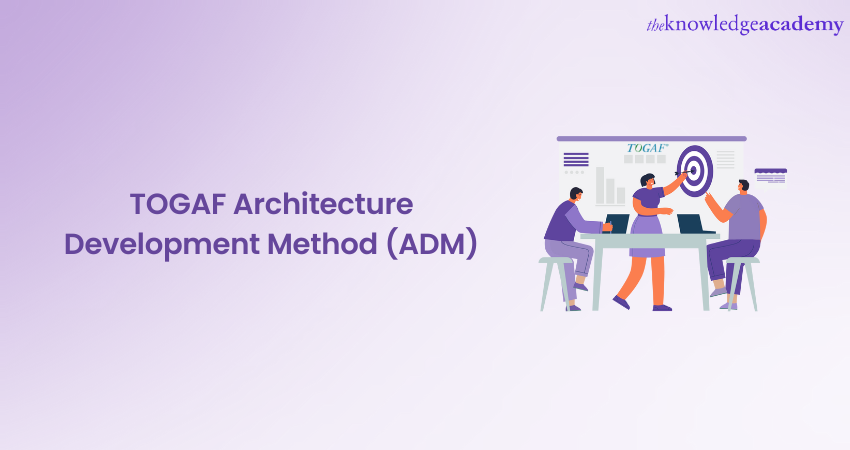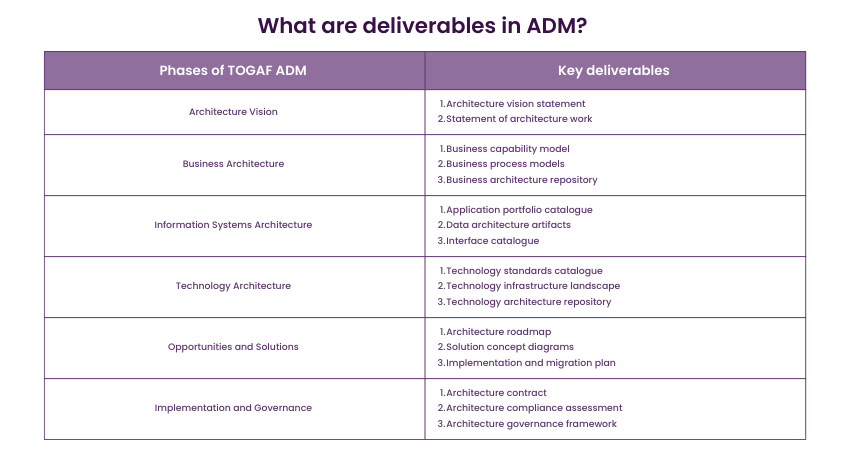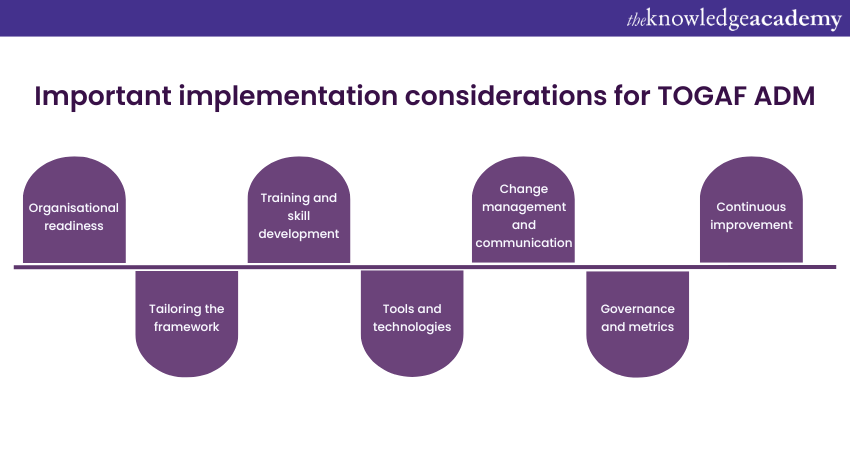We may not have the course you’re looking for. If you enquire or give us a call on 01344203999 and speak to our training experts, we may still be able to help with your training requirements.
Training Outcomes Within Your Budget!
We ensure quality, budget-alignment, and timely delivery by our expert instructors.

With the ever-growing complexity of the Information Technology (IT) landscape, organisations seek a framework that could provide guidance and structure throughout the architectural development process. TOGAF Architecture Development Method (ADM). The TOGAF Architecture Development Method has emerged as a response to these challenges, offering a comprehensive methodology.
Today, over 80% of the Forbes Global Top 50 companies use TOGAF ADM, according to The Open Group Architecture Forum. It has helped them align their IT strategies with business objectives, enhance interoperability, and drive successful architectural transformations. So, if your organisation also wishes to organise IT architecture, read the blog to learn about the TOGAF Architecture Development Method. Also, learn about its key components, including the phases and guidelines.
Table of contents
1) TOGAF ADM – An overview
2) Architecture Development Method principles
3) Implementing the TOGAF ADM cycle
4) Important implementation considerations for TOGAF ADM
5) Why adopt TOGAF ADM?
6) Conclusion
TOGAF ADM – An overview
TOGAF ADM, developed by The Open Group, is a highly regarded methodology for developing an Enterprise Architecture. The Open Group has also suggested specific changes in its Architectural Development Method Documentation.
At its core, ADM aims to align IT strategies with business goals. Emphasising stakeholder engagement and collaboration provides a structured and systematic approach to developing and managing their architectural landscapes. The method encompasses iterative phases with defined steps and deliverables to guide the architectural development process.
It provides organisations with a common language and a set of best practices and resources, enabling them to establish and evolve their architectural capabilities. This helps organisations achieve better interoperability, optimise resource allocation, and align their IT initiatives with long-term business strategies.
TOGAF ADM input and output
The TOGAF ADM involves a series of inputs and outputs that drive the architectural development process. These inputs and outputs provide valuable information, artefacts, and deliverables at various phases of the ADM. Let’s explore the key inputs and outputs of TOGAF ADM:
The following inputs are involved in the architecture development process:
a) Business architecture input: Strategies, goals, requirements, and stakeholder needs.
b) Stakeholder input: Perspectives, concerns, and requirements from various stakeholders.
c) Reference models and architectural principles: TOGAF reference models and organisational principles.
d) Organisational standards and guidelines: Standards, policies, and frameworks.
e) The following outputs are achieved after each phase of the ADM iteration cycle:
f) Architecture vision: High-level view of the desired future state.
g) Architecture definition document: Detailed description of the target architecture.
h) Architecture requirements specification: Functional and non-functional requirements.
i) Architecture roadmap: Transition plan from baseline to target architecture.
j) Architecture deliverables: Business capability models, information models, solution architectures, etc.
k) Architecture change request: Proposed changes to the architecture.
What are deliverables in ADM?
The ADM in TOGAF produces various deliverables at different phases of the architectural development process. These deliverables are tangible artifacts that capture and communicate important aspects of the architecture. Here are some key deliverables in ADM:

Architecture Development Method principles
The ADM is guided by principles that shape the approach and mindset for developing effective enterprise architectures. These principles provide a foundation for architects to make informed decisions and drive successful architectural transformations. Here are the key principles of ADM:
a) Iterative and cyclical approach: ADM adopts an iterative and cyclical approach, allowing for continuous improvement. This iterative nature enables flexibility and adaptation to changing business needs.
b) Stakeholder-centric focus: The methodology places a strong emphasis on understanding and addressing stakeholder needs. Architects actively engage with stakeholders throughout the process, ensuring their perspectives, requirements, and concerns are considered.
c) Holistic enterprise view: It takes a holistic view of the enterprise by considering multiple architectural domains. It recognises the interdependencies and interconnectedness of these domains, such as Business, Data, Application, and Technology. Therefore, ADM ensures coherence, alignment, and effective integration across the architecture.
d) Reuse and standardisation: This method promotes the reuse of architectural assets, patterns, and best practices. By leveraging existing resources, architects can save time, effort, and costs while maintaining consistency and quality. Adhering to industry standards and frameworks further enhances interoperability and accelerates architectural development.
e) Risk and value-driven: ADM also incorporates risk and value-driven mindset. Architects proactively identify and manage risks throughout development to minimise potential negative impacts.
f) Governance and compliance: It ensures adherence to governance and compliance requirements. Architects establish governance mechanisms to monitor and control the architecture’s development and implementation. They also ensure compliance with organisational policies, industry regulations, and relevant standards.
Implementing the TOGAF ADM cycle
TOGAF ADM consists of eight distinct phases, each designed to address specific aspects of the architectural development process. These phases provide a structured approach for creating and evolving enterprise architectures. Let's explore each phase and its associated steps:
1) Preliminary Phase
The preliminary phase is the preparation and initiation phase, where activities relating to creating architectural capabilities occur. TOGAF ADM lays the foundation for organisations to define the necessary framework and adapt to the model to suit business needs. The architecture development is further divided into eight phases that are as follows:
Phase A: Architecture Vision
As the name suggests, this phase involves designing a plan for business architecture. The activities involved in defining architecture vision are as follows:
a) aIdentifying the stakeholders and their concerns
b) Defining the architecture vision, including the purpose, scope, and key architectural requirements
c) Creating a statement of architecture work that outlines the tasks and deliverables for the overall architecture development process
Phase B: Business Architecture
This phase revolves around setting business goals for the organisation and its architectural elements. The activities that take place during this phase include:
a) Developing a baseline business architecture by understanding the current state of the organisation
b) Defining the target business architecture, aligning it with the business goals and strategies
c) Conducting gap analysis to identify areas where the current and target architectures differ
Phase C: Information Systems Architecture
Phase C covers data and application architecture development to support the architecture vision. It involves the following:
a) Developing a baseline information systems architecture by analysing the existing systems and data flows
b) Defining the target information systems architecture, focusing on integration, interoperability, and data consistency
c) Performing gap analysis to identify gaps between the current and target architectures
Phase D: Technology Architecture
This phase involves developing the structure and interaction of the platform services, along with logical and physical technology components.
a) Developing a baseline technology architecture by assessing the existing technology infrastructure
b) Defining the target technology architecture, considering emerging technologies and business requirements
c) Conducting a gap analysis to identify discrepancies between the current and target technology architectures

Phase E: Opportunities and Solutions
Phase E is dedicated to finding opportunities by implementing specific solutions for delivering the desired architecture. It involves conducting the following activities:
a) Identifying and assessing potential architecture projects and initiatives
b) Evaluating the feasibility, business value, and risks associated with each opportunity
c) Developing an architecture roadmap that outlines the prioritised projects and their timelines
Phase F: Migration Planning
Migration Planning is the phase where comprehensive implementation of the architectural roadmap takes place. The baseline developed in previous stages is migrated to the target architecture for successful implementation. The activities involved in this phase are as follows:
a) Creating a detailed plan for implementing the target architecture, considering sequencing, dependencies, and resource allocation
b) Defining the transition architectures that provide intermediate steps towards the target architecture
c) Developing an implementation and migration strategy to guide the execution of the architecture plan
Phase G: Implementation Governance
Changes made in the TOGAF architectural roadmap and other architectures are implemented in this phase. It involves controlling bottlenecks and maximising contributions made to these projects. The activities involved in this phase are:
a) Establishing governance mechanisms to monitor and control the implementation of the architecture
b) Managing architecture contracts, compliance, and performance measurements
c) Conducting architecture reviews and audits to ensure alignment with the Architecture Vision
Phase H: Architecture Change Management
This phase focuses on establishing methods for managing changes in the new architecture. The activities that take place during this phase are as follows:
a) Establishing a process for managing and addressing requests for changes to the architecture
b) Assessing the impact of proposed changes and making informed decisions on their implementation
c) Updating the architecture documentation and communicating the changes to relevant Stakeholders
ADM Architecture Requirements Management
ADM Architecture Requirements Management focuses on capturing, analysing, and managing architectural requirements. It involves:
a) Identifying and documenting requirements using techniques such as interviews, workshops, and surveys to elicit and capture requirements effectively
b) Categorising and prioritising the requirements based on their significance and impact on the architecture
c) Analysing feasibility and alignment
d) Establishing traceability
e) Facilitating communication and collaboration among stakeholders
f) Effective Requirements Management ensures the architecture meets stakeholder needs and aligns with business goals.
Important implementation considerations for TOGAF ADM
Implementing the TOGAF Architecture Development Method benefits organisations in several ways. Let’s delve into the benefits of adopting the TOGAF ADM:

a) Organisational readiness: The first thing is to assess the organisation's readiness and capability to adopt TOGAF ADM. Evaluate executive sponsorship, resources, skills, and organisational culture. Address any gaps or challenges before embarking on the implementation.
b) Tailoring the framework: TOGAF ADM is a flexible framework that can be tailored to fit an organisation's specific needs and context. The architects should consider adapting and customising the ADM phases, steps, and deliverables to align with the organisation's existing processes, methodologies, and governance frameworks.
c) Training and skill development: While implementing TOGAD ADM, the architects and other key Stakeholders involved in the architecture development process should ensure appropriate training on the methodology. Providing opportunities for skill development, certification, and continuous learning can enhance their understanding and proficiency in using the framework effectively.
d) Tools and technologies: The Architects should evaluate and select suitable tools and technologies that support the implementation of TOGAF ADM. These tools can aid in documentation, modelling, analysis, and collaboration, streamlining the architecture development process and improving productivity.
e) Change management and communication: Organisations must recognise that implementing TOGAF ADM involves making changes within the organisation. Therefore, organisations should develop a comprehensive change management plan that addresses Stakeholder engagement, communication, and training needs. Effective communication about the architecture initiative's benefits, objectives, and progress can further help gain support and promote collaboration.
f) Governance and metrics: Another point to keep in mind is establishing a governance framework to oversee the implementation of TOGAF ADM. It involves defining roles, responsibilities, and decision-making processes to ensure proper governance and compliance. Further, developing metrics and key performance indicators (KPIs) to measure the effectiveness, progress, and value delivered will assist the architecture development process.
g) Continuous improvement: Lastly, the Architects should embrace a culture of continuous improvement by incorporating feedback and lessons learned from each architecture development cycle. Regularly reviewing and refining the implementation approach, processes, and tools can enhance efficiency and effectiveness. It can also help in better alignment with organisational goals.
Learn how to align business strategy with IT capabilities. Register for our TOGAF® BA Foundation Training now!
Why adopt TOGAF ADM?
The Architecture Development Method (ADM) offers numerous benefits and holds significant importance for organisations seeking to develop and manage their enterprise architectures effectively. Here are some key benefits and reasons why TOGAF ADM is crucial:
1) Standardisation and best practices: TOGAF ADM provides a standardised approach to enterprise architecture development, ensuring consistency and uniformity across organisations. It further incorporates industry best practices and proven methodologies, enabling architects to leverage established frameworks and resources.
2) Efficient decision-making: The method facilitates informed decision-making by providing a structured framework and comprehensive set of guidelines. It helps architects assess alternatives, evaluate risks, and consider stakeholder requirements, resulting in well-informed decisions throughout the architectural development process.
3) Stakeholder alignment and engagement: It also emphasises stakeholder engagement and alignment by involving them in various phases. ADM also considers their perspectives, needs, and concerns, leading to a better alignment of the architecture with business goals.
4) Enhanced interoperability and integration: ADM's holistic approach promotes interoperability and integration across the enterprise. It enables seamless data flow, smooth application integration, and efficient technology infrastructure alignment, reducing potholes and enhancing organisational efficiency.
5) Risk mitigation and compliance: TOGAF ADM addresses risk management and compliance requirements. It facilitates identifying and mitigating risks throughout the architectural development process, ensuring the architecture aligns with security standards, regulatory frameworks, and organisational policies.
6) Flexibility and adaptability: The iterative nature of ADM offers flexibility and adaptability for changing business needs and technological advancements. Architects can continuously refine and adjust the architecture based on feedback and lessons learned, ensuring its relevance and effectiveness over time.
7) Business value and Return on Investment (ROI): ADM’s focus on maximising business value and ROI helps align architecture decisions with strategic goals. It also prioritises initiatives based on value contribution and optimises resource allocation. Therefore, ADM assists businesses in achieving tangible business benefits and optimising their investments.
Conclusion
TOGAF Architecture Development Method is a valuable guide for architects and organisations seeking to develop and manage enterprise architectures efficiently. It promotes collaboration, consistency, and strategic alignment, enabling organisations to adapt to changing business needs, leverage technology advancements, and achieve their desired outcomes.
Learn the business and security architecture with our TOGAF® Essentials course. Join now!
Frequently Asked Questions
Upcoming Business Improvement Resources Batches & Dates
Date
 TOGAF® Foundation and Practitioner Training
TOGAF® Foundation and Practitioner Training
Sat 3rd Aug 2024, Sun 4th Aug 2024
Mon 5th Aug 2024
Mon 12th Aug 2024
Sat 17th Aug 2024, Sun 18th Aug 2024
Mon 19th Aug 2024
Mon 2nd Sep 2024
Sat 7th Sep 2024, Sun 8th Sep 2024
Mon 9th Sep 2024
Mon 16th Sep 2024
Sat 21st Sep 2024, Sun 22nd Sep 2024
Sat 5th Oct 2024, Sun 6th Oct 2024
Mon 7th Oct 2024
Mon 14th Oct 2024
Mon 21st Oct 2024
Sat 2nd Nov 2024, Sun 3rd Nov 2024
Mon 4th Nov 2024
Mon 11th Nov 2024
Sat 16th Nov 2024, Sun 17th Nov 2024
Mon 18th Nov 2024
Mon 2nd Dec 2024
Sat 7th Dec 2024, Sun 8th Dec 2024
Mon 9th Dec 2024
Mon 16th Dec 2024
Mon 6th Jan 2025
Mon 27th Jan 2025
Mon 3rd Feb 2025
Mon 10th Feb 2025
Mon 17th Feb 2025
Mon 24th Feb 2025
Mon 3rd Mar 2025
Mon 10th Mar 2025
Mon 17th Mar 2025
Mon 24th Mar 2025
Mon 31st Mar 2025
Mon 7th Apr 2025
Tue 22nd Apr 2025
Tue 6th May 2025
Mon 12th May 2025
Mon 19th May 2025
Mon 2nd Jun 2025
Mon 9th Jun 2025
Mon 16th Jun 2025
Mon 23rd Jun 2025
Mon 7th Jul 2025
Mon 21st Jul 2025
Mon 28th Jul 2025
Mon 4th Aug 2025
Mon 11th Aug 2025
Mon 18th Aug 2025
Mon 1st Sep 2025
Mon 8th Sep 2025
Mon 15th Sep 2025
Mon 22nd Sep 2025
Mon 29th Sep 2025
Mon 6th Oct 2025
Mon 13th Oct 2025
Mon 20th Oct 2025
Mon 27th Oct 2025
Mon 3rd Nov 2025
Mon 10th Nov 2025
Mon 17th Nov 2025
Mon 24th Nov 2025
Mon 1st Dec 2025
Mon 8th Dec 2025
Mon 15th Dec 2025







 Top Rated Course
Top Rated Course



 If you wish to make any changes to your course, please
If you wish to make any changes to your course, please


